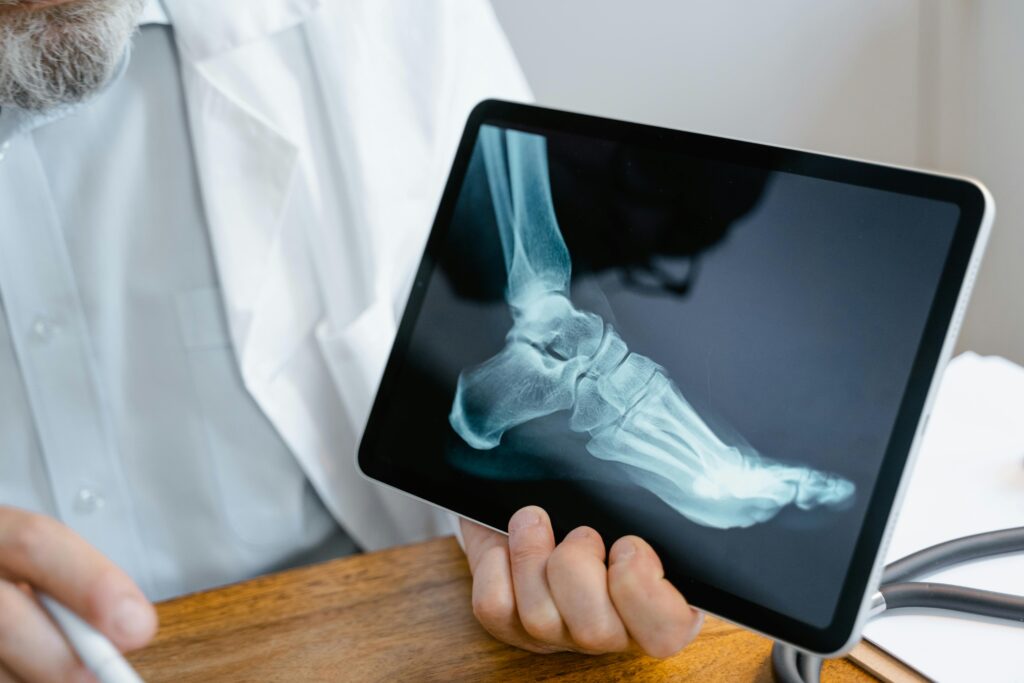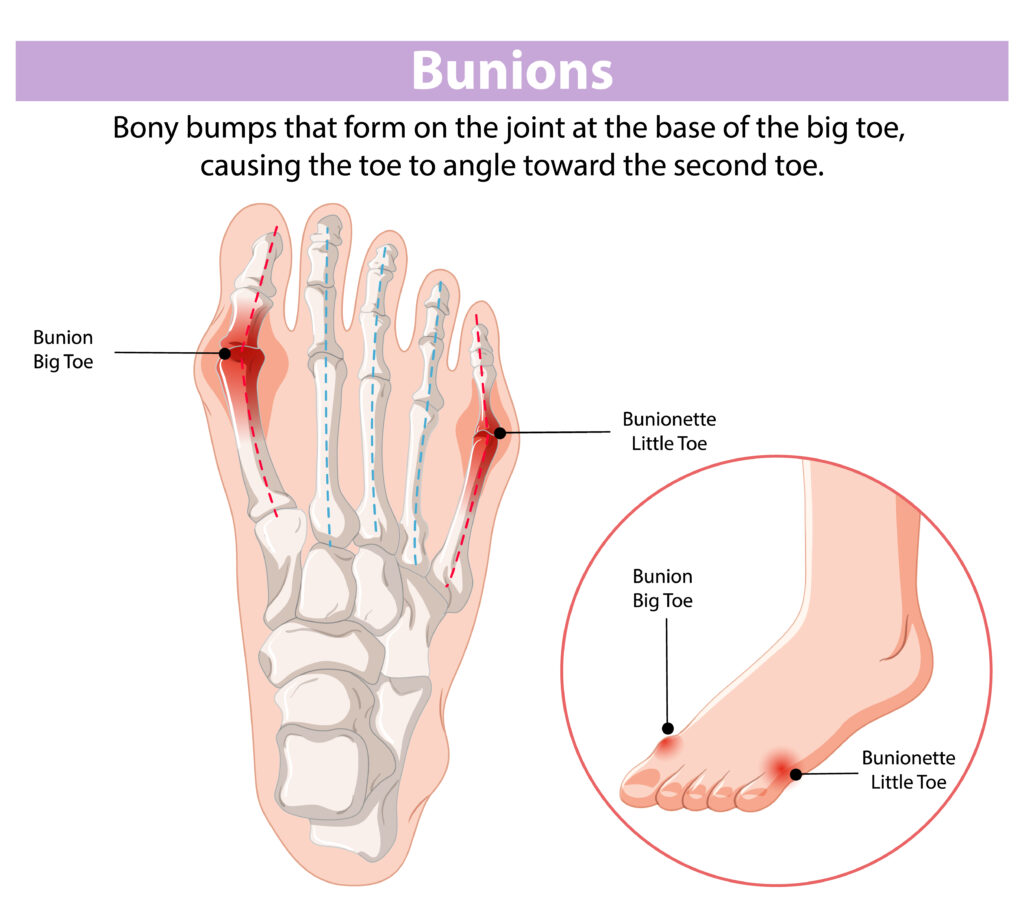
Bunion Treatment at Suburban Foot & Ankle Center
What Exactly Is a Bunion?
A bunion is, basically, a bony bump that is developed on the base of your big toe. When the bones that are in the front part of your foot shift out of their natural position, the big toe will start to point towards the direction of the rest of your toes. This misalignment is due to the fact that the MTP joint, being the big toe joint on the foot, is malfunctioning which in turn causes the bump that is visible and could be painful.
The bunion will progressively worsen over time if left untreated, leading to increased pain. If you experience any of the following symptoms, it is advisable to consult a doctor for a personalized evaluation and treatment plan.
- A noticeable bump on the side of your big toe.
- Pain or discomfort, especially when wearing shoes.
- Trouble bending or moving your big toe.
- Redness, swelling, or irritation around the joint.

Types of Bunions
Traditional Bunion: It is the usual form and is generally observed at the beginning of the big toe. As time goes by, the big toe leans toward the small ones, thus the joint sticks out, and a bump forms.
Bunionette (Tailor’s Bunion): A bunionette is a small bump that gets bigger at the internal side’s bottom of the pinky toe. This is because of the same reasons as a typical bunion, including wearing shoes that are too tight or some foot injuries.
Why Do Bunions Develop?
Generally, bunions arise when there is excessive pressure on the joint at the base of the big toe, which causes the bone to gradually slip out of place. There can be a few reasons for this, and it is usually a matter of several factors:
- Bunions can be hereditary. If your parents have them, you are likely to too.
- The toes are pushed out of position due to the tight, narrow shoes or high heels.
- Arthritis and other inflammatory infections of the joint may cause a worsening of the bunion through joint swelling.
- Past foot injuries may cause a problem with the way you walk, thus, putting more pressure on the affected toe joints.
- Flat feet or pes planus as well as high arches or pes cavus can lead to bunions as they put higher pressure on the big toe joint.
Signs and Symptoms of a Bunion
A bunion might be part of your life if the following signs and symptoms come your way. Please, consider them!
- Pain and Discomfort: Some painful sensations might emerge around the big toe joint, especially when you walk or wear tight shoes.
- Visible Bump: A visible, bony growth appears on the lateral side of your big toe, which grows over time.
- Difficulty Moving the Big Toe: A misalignment in the toe joints can be an obstruction to the bending or movement of the big toe to the desired extent.
- Redness and Swelling: The skin that covers the bunion might turn red, appear swollen, or even get irritated from the constant rubbing of the shoes.
- Calluses or Corns: It is most likely that you will get those areas with thickened skin that come out when the toes meet or over the big toe joint.
- Soreness: You may feel a painful or tender sensation in the affected area, especially after standing or walking for a long time.
You are on the right path to have a better understanding of what pain is if you report it this way.You might have a bunion and these might be the main signs and symptoms of it. You should see a specialist to get it checked. A bunion can be very uncomfortable and should not be overlooked.
Practical Tips for Preventing Bunions
While familial inheritance is a major contributor to this, there are certain things you can do to reduce the risk of getting bunions:
- Select the Right Shoes: Settle for shoes having a wide toe box, low heels, and good arch support in order to alleviate the discomfort caused by your toes. Minimize the Risks by
- Avoiding Tight Shoes: Ensure the shoes you buy do not crowd or squeeze your toes since it is the overall effect at the end of the day, pushing your toes out of alignment.
- Look at Orthotics: If you have flat feet or are already dealing with some other foot problems, trying orthotic insoles will be helpful in correcting your foot structure and thereby avoiding bunions.
- Practice Foot Exercises: Daily toe stretching and strengthening exercises can keep your toes in the right place and there will be less pressure on your joints, hence experiencing less pain.
By doing the above the feet will be shielded from bunions, whereas wearing a shoe that is out of the line of the toe is one notorious cause of the disease.
How Are Bunions Treated?
Bunions do not always require surgery, in most cases, they can be treated by other means. But for more severe ones, surgical operations are the only option. In the following, we present the most common of those treatments:
- Shoe Changing: Shoes that have a wide toe box and low heels not only work very well on a bunion but also you don’t have to be too restrictive with the style. However, tight and pointed shoes should be kept away.
- Manual Therapy Tools, Bunion Pads & Taping: Apply foot isolation rings, pad-like materials, or bunion socks. In some cases, medical tape might also be beneficial.
- Over-the-counter pads: Place these under the skin to cushion the affected area. When you continue doing these exercises, you will naturally start holding a perfect ankle and plantar fascia, which could further fix the bunion condition. Plus, with these OTC pads, your feet are being protected from being rubbed and to further solve the situation you can use medical tape to make your feet be aligned to the appropriate position.
- Orthosis/Braces: Orthosis is another non-surgical treatment option but it must be about an off-the-shelf or a personalized one, with an arch raising pad beside.
- Painkillers: Nonsteroidal anti-inflammatory drugs (NSAIDs) such as ibuprofen can help in relieving swelling, and also relieve the discomfort by reducing the pain, alternatively, they can also be used as a topical application for better outcomes.
- Ice therapy: Nowadays it is the most common way of reducing swelling and pain when people put ice on the wound.
- Corticosteroid injection: Sometimes your doctor might need to give you some steroids for your inflamed body part to go down and consequently decrease your pain.
- Physical exercises: Exercises allow muscles in the foot to gain strength and make it easy to keep the toe in place. By reducing the pressure that the big toe is subjected to, the alignment will improve.
- Surgery: The last option would be a surgical procedure if everything else failed. Consequently, the Bunion surgery is for coping with severe bone problems only. The surgery treats the toe or other joints which might be the cause of the misalignment.
Make an appointment with a healthcare provider for treatment that is in line with your health condition.
When Should You See a Healthcare Provider for a Bunion?
You should immediately visit a healthcare provider or podiatrist whenever you exhibit any of the following:
- Pain in your foot or toes: If you are currently having pain, mainly when standing or walking.
- Difficulty walking or moving your foot: If you have a hard time walking or moving your toes freely and comfortably because of the discomfort.
- A noticeable bump at the base of your big toe: In case you feel a bump that is getting bigger slowly.
- Swelling around your toes: Discoloration or swelling around the concerned area, usually from friction or irritation.
Though not always the case, sometimes bunion problems can be fixed by lifestyle changes, it is very important to be seen by a professional first. Early treatment can help avoid the need for a drastic course of action and the situation can be controlled better.
Frequently Asked Questions
How to Shrink Bunions Naturally?
The natural way to fully reverse a bunion is not yet found, but you can seek relief by wearing shoes with a wide toe box, utilizing bunion pads, and doing foot exercises. Ice and custom orthotics may also bring you relief. Talk to a doctor about the best treatment plan.
How Can I Prevent Developing a Bunion on My Other Foot?
To prevent the right foot getting bunions, wear comfortable shoes with a view of an open toe, choose orthotics, and use foot exercises. Be careful and actually stop the development as soon as you notice the first signs of discomfort. In order to keep the weight equally balanced and get through these first moments, an optimal weight should be a priority.
Do You Accept Insurance for Bunion Treatment?
Yes! FootAnkleIL proudly accepts insurance from a wide range of providers. You can find the full list on our Insurance Page. If your provider isn’t listed, our knowledgeable team is happy to assist you in exploring your options.
What is 3D/4D Lapiplasty® Bunion Surgery?
3D/4D Lapiplasty® is a surgical operation that reconstructs the bones of your big toe in three dimensions by giving way for enduring and fast healing. This is a nearly noninvasive method that helps to restore the original condition of the foot. Talk to a doctor about it to determine if it’s suitable for you.
